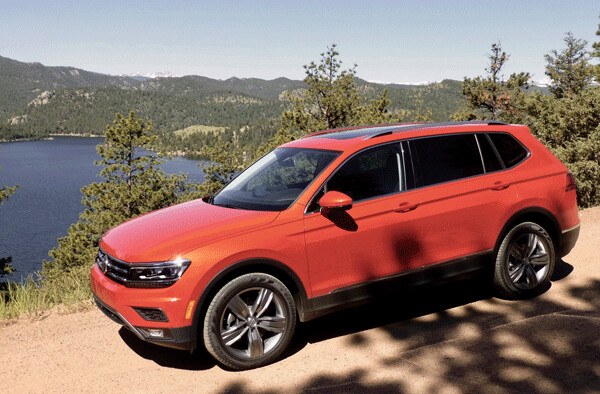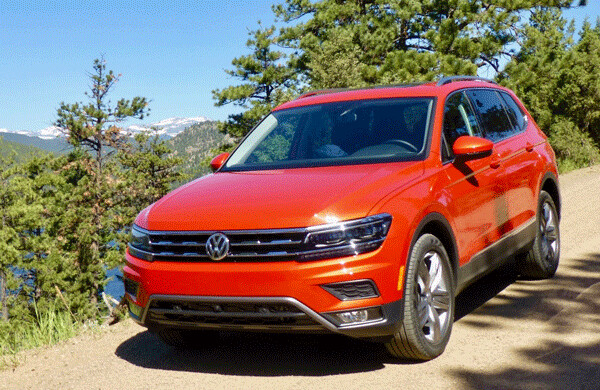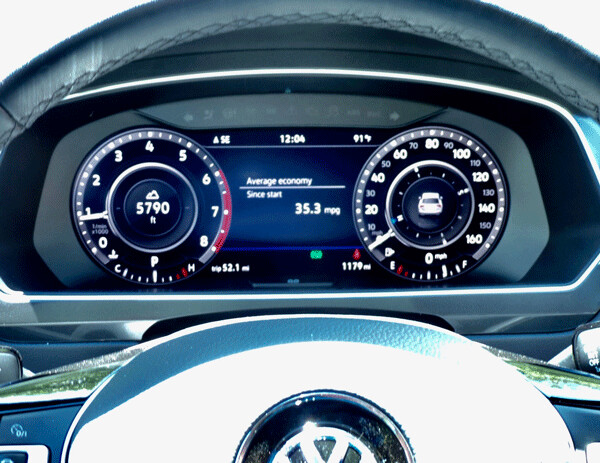News & Articles
Browse all content by date.

Just west of Denver, the Rocky Mountains rise from the Mile High City’s 5,240 feet to peaks jutting more than 10,000 feet into the sky. They can be traversed by twisting roads up to and along the Continental Divide, but you do it with care, and you’d best have a vehicle that handles with great precision.
What better place for Volkswagen to introduce its new 2018 Tiguan? After all, a Tiger, or an Iguana, could make that climb with ease, and legend has it that back in the days when VW assigned real-world elements to its vehicles — Golf for gulf wind, Jetta for jetstream, Scirocco for desert wind, etc. — somebody decided that the first stubby and squarish sport-utility vehicle might best be named by combining the steal of the tiger and the lizard-like road-holding of the iguana.

Far as we could tell, there were no tigers, nor iguanas, out cavorting in the 98-degree heat during our wave of the global launch of the all-new Tiguan. But that’s OK; the new Tiguan handled every road-challenging turn and switchback with great poise and delivered impressive power and fuel economy both on the way up and coming back down to our base at the Halcyon Hotel in suburban Cherry Creek.
My driving partner was a fellow we’ll call Wayne, an incurable devotee to fuel efficiency. He slows down a block away when he sees a street light turn red ahead, so that he can avoid gas-robbing stop-and-goes, where moderate speed can allow him to continue forward. He also doesn’t exceed the speed limits on suburban streets, causing others in our group to line up behind us in frustration.
But when we partner, I find myself driving more rationally, and trying to also maximize fuel efficiency even while using more burst of power to exercise a vehicle’s handling capabilities. We both like to stop and shoot photos at scenic spots. So this was a good match.

The night before our drive, we gathered at the hotel’s penthouse suite for a buffet dinner that was outstanding. It was there we heard some other journalists who had just finished the previous wave grumbling about the Tiguan’s lack of power and boring ride characteristics. We were not anticipating anything outstanding, but the Tiguan delivered exactly that in surprising quantities.
I never disliked the original Tiguan, stubby and square though it is, it just seemed to lack the style brought about by the new explosion of compact crossover SUVs.

After all these years, this will be the first renovation of the Tiguan, and the old Tiguan will continue to be built for the near future as the Tiguan Limited. Every company making SUVs are now caught up in the craze to make smaller and more compact models, and here is Volkswagen, already with a reasonable compact, choosing to build a larger one.
The new one is 10.7 inches longer and it fits on VW’s excellent new MQB platform, a modular chassis that can house every car and SUV with a transverse engine design. The side-mounted engine at the front of the new Tiguan is the familiar 2.0-liter turbocharged 4-cylinder, except it is entirely new. VW’s engineers are always creating new concepts in engine building. They have made a 2.0 for decades and it has served the company well in all manner from efficient to the screaming powerplant of the GTI. More recently, VW added a 1.8-liter engine that was a downsized derivative of the 2.0.

And one year ago, VW came out with a superb new 1.4-liter turbo that is the first of an entirely new high-tech family of engines. So when I learned the Tiguan would have a 2.0, I had to ask Mark Gillies if this one was an enlarged version of the 1.4 or a redone version of the old 2.0.“It actually is a revised version of the EA 888 — the old 2.0,” said Gilles, senior manager of production and technology for Volkswagen of America. “It is called the ‘Butack’ engine, named after the engineer who designed it with a revised Miller-cycle system that closes the intake valves early, increasing combustion time, and allos the variable cams to open longer and wider when you need more power.”
There is another example of VW engineering genius. With new engines seeming to aim at replacing old ones, VW keeps the old ones around back in the laboratory where an engineer named Butack might find the time to extract a whole new future for it.
The new engine has 184 horsepower, which, surprisingly is a slight decrease from the 200 horses of the existing 2.0, but it has 221 foot-pounds of torque for a healthy increase over the 207 foot-pounds of its predecessor. All that new torque comes in from a range that runs from the mid-teens to high RPMs, giving the new engine significantly more pulling power than the numbers might imply.

Wayne drove first and got some great roads to climb on the way up. He also did all his high-mileage tricks — not revving up the engine, never pushing it — and when the altitude meter on the instrument computer showed that we had climbed form 5,200 feet to 8,600, the trip computer also showed he had gotten 43 miles per gallon. That was a big surprise, because even though he was pampering it, the EPA estimate on the engine shows 27 miles per gallon highway, and they didn’t mean highways to the sky in 98-degree heat!
I got my chance on the next leg, and I pushed the Tiguan a lot. I also cheated, however, because for one long, 20-mile stretch, we were coming down from the mountains and though the road continued to twist and turn, I let it go, stabbing the brakes whenever we approached a curve, and sweeping around them at considerable speed. I never once touched the gas pedal, so I was able to boast that the gauge showed 190 miles per gallon on that segment.
When we got back, the overall figure for my driving was 36 mpg, which is still a large jump from 27, and hardly reflected my more vigorous and aggressive driving. The Tiguan handled it all with predictable lack of body roll and was the latest example of how solid VW builds vehicles and how impressive the steering and suspension coordinate with the vehicle.
The new Tiguan will get to showrooms by the end of summer and will start at $26,245 for the front-wheel drive version of the base S. Moving up through the SE, the SEL, and SEL Premium, and adding the excellent fifth generation all-wheel drive clutchpack with its center differential, you can get it up to $38,450. The all-wheel drive defaults to front-wheel drive only in normal driving, but the always-active 4-Motion awd kicks power to the rear whenever there’s a hint of need.
Typically, the Tiguan comes well-equipped even at the base level. The greater length allows room for a thrid-row seat that the first Tiguan couldn’t house. It comes standard in fwd models and is an option on the 4-Motion system — which is available on all models from SE up.
Tiguan product manager Jeff Ng pointed out the longer wheelbase that pushes the wheels out to the extremities, making more room inside. A character line is carved into the sides, running from the tops of the wheelwells all the way to the rear, where it blends into the taillights and continues across the rear hatch.

The full suite of safety elements are standard in all models, as are things such as start-stop to save fuel, and a rear camera. Moving up in trim levels finds some lucrative options, such as a full length sunroof that covers first and second row seats, customizable instruments with Apple CarPlay and Android Auto, navigation system with Sirius Travel Link, front warning with pedestrian protection, blind spot detection and alert, lane-assist warning, 4-camera area view from overhead, adaptable cruise control with the ability to come to a complete stop behind a car you’re following, and start up again to maintain the preset distance, automatic high-beams, and sportier interiors if desired.
Fender Premium audio is another feature, with 480 watts of power and nine speakers of Panasonic’s best stuff. It works as advertised, and adds a pleasurable touch to normal driving, although we found climbing the Rocky Mountains, and coming back down, to be compelling enough to prove that the new Tiguan can charge like a tiger and slink around corners like an iguana, and sometimes both at the same time.
| Tweet |


